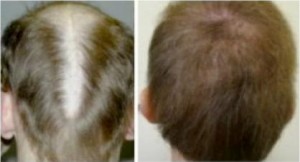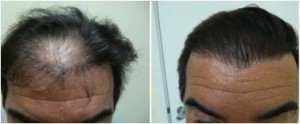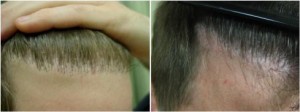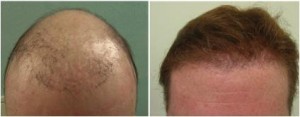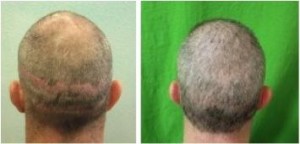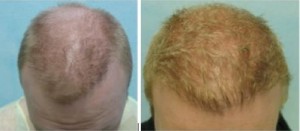Hair transplant repair employs surgical hair restoration techniques to correct a previously botched procedure of a similar nature. The reasons for needing a corrective surgery are usually:
- -An antiquated method was used
- -A novice or unskilled surgeon was used
Many past hair restoration surgeries used methods that are now considered obsolete. These outdated technologies can haunt a patient 10 or 20 years later with unsightly scars and subpar yield. Additionally, an inexperienced surgeon can do more harm than good, also producing scars, poor yield, and unfavorable results overall. For a recipient of botched surgery living in a metropolitan hub like Los Angeles, hair transplant repair is practically a necessity, with such high cosmetic social and professional standards. Often, a corrective surgery is the only means of regaining a normal cosmetic appearance.
Fortunately, hair restoration technology has improved by leaps and bounds in recent years. Disfigured patients with no donor source are getting a second chance with the implementation of follicular unit extraction and body hair transplant.
TYPES OF REPAIR CASES
As long as the prospective patient is a good candidate health-wise and he has adequate non-head donor hair, corrective surgery is possible. The most common outdates surgeries or types of damage that qualify for a Los Angeles hair transplant repair include:
- -Scalp reduction
- -Temporoparietal-occipital flap surgery
- -Punch grafting
- -FUT/linear scars
- -“Doll’s hair” appearance
- -Poorly placed/angled hair
- -Asymmetry
- -Depleted scalp donor source
- -Abrasive hairline
Scalp Reduction
This surgery excises the bald crown area from the scalp by cutting it out. The surrounding hair-bearing skin is then brought together and sutured shut to give the appearance of global density. This highly invasive surgery poses several risks and complications, including infection, hypoesthesia, scarring, and slot formation.
This Los Angeles hair transplant repair patient had several types of surgical hair restorations done previously—to include FUT and punch grafting—but was perhaps worst damaged by multiple scalp reductions. Dr. Umar harvested 22,000 grafts from the patient’s chest, shoulders, stomach, and beard, and head. His repair was life-changing.
Temporoparietal-Occipital Flap Surgery
Flap surgery excises two rectangular flaps of flesh from the posterior-sides of the scalp. Each remains connected at the foremost edge of flesh, where it is rotated and attached to the anterior hairline. This method has become a common source of botched surgery, resulting in reverse direction of hairline growth, scarring, hypoesthesia, and more.
This Los Angeles hair transplant repair patient had undergone a flap surgery that produced an unfavorable appearance. Dr. Umar’s FUE uGraft surgery repaired him with 2,050 grafts from the head and nape.
Doll’s Hair and Punch Grafting Scars
The “doll’s hair” appearance is caused by outdated punch grafting methods that used much larger punches (up to 4mm) than today. Large circular scars became apparent after healing, and the recipient area grew “plugs” or small tufts of hair that looked like the hair of a doll.
For years, this Los Angeles hair transplant repair patient dealt with severe ridging and a pluggy hairline as a result of punch grafting. Dr. Umar removed his “doll’s hair” implants and used follicular unit extraction to rebuild the hairline, giving it a soft, natural appearance.
This Los Angeles hair transplant repair patient underwent punch grafting previously, but the implants yielded no new hair. He was then left bald and scarred. A hairpiece was his only reprieve, but he still needed a real hairline to make the toupee blend in. Dr. Umar employed body hair transplant to give the patient a new hairline and make his hairpiece undetectable.
Follicular Unit Transplant (FUT)
FUT is also known as strip harvesting. This method excises a strip of skin from the mid-back of the head to be later dissected into implantable follicular units. It is known for the inevitable linear scar it creates—which often stretches over time.
This Los Angeles hair transplant repair patient was disfigured by two uneven strip scars. Tattooing the scars didn’t help, so he presented to Dr. Umar. After 1,200 FUE grafts to conceal the scars, his history of FUT is untraceable.
Poorly Placed/Angled Hair and Asymmetry
These results can occur with any type of hair restoration surgery and rely on the surgeon’s skill to be executed correctly.
This Los Angeles hair transplant repair patient had a plethora of problems; a harsh hairline, irregular coverage, and poorly angled growth. Furthermore, his head donor source was depleted. Dr. Umar repaired his scalp with 9,000 FUE grafts from head, nape, chest, and beard.

Patient with poorly angled hair from past procedure was able to restore a normal appearance with his hair transplant repair.*
A prior FUE procedure left this patient with asymmetrical results. He wanted to add density and get more even placement of the grafts. Dr. Umar used 6100 grafts from the beard, body, and head to achieve a favorable outcome with this hair transplant repair.
Depleted Donor Source
Any surgery that results in disfigurement or excessive scarring usually depletes the donor source. This can also be true of too many attempts at unsatisfactory procedures.
This patient underwent numerous prior surgeries, going back as far as 25 years. He had pluggy growth, severe scarring, and no scalp donor hair left. Dr. Umar’s repair consisted entirely of non-head donor sources, with 2,000 grafts form the beard and 8,000 from the stomach, arms, and legs.
Harsh Hairline
This typically happens with techniques that confine the surgeon to hair from the mid-rear scalp only, such as FUT. This traditional donor zone is where hair grows thickest, and thus produces the harshest hairline design.
This Los Angeles hair transplant repair patient had three FUT surgeries before realizing strip harvesting would not deliver the hairline he wanted. Dr. Umar achieved a much more gradual and soft hairline with only 1,000 FUE grafts.
FINDING THE RIGHT REPAIR SURGEON
Undergoing a procedure with the wrong surgeon can wreak havoc on a person’s quality of life in the aftermath. The following video depicts the emotional journey of a repair patient, which is often wrought with trauma, skepticism, and emotional turmoil.
Needless to say, it is paramount to be vigilant when researching surgeons. Finding a highly skilled Los Angeles hair transplant repair practitioner will greatly reduce risks, complications, and unwanted outcomes. Always seek a doctor who has the following:
- -Board certifications/licensing, preferably in dermatology or plastic surgery
- -Photo and video record of prior patient results
- -Experience
- -Skill/artistry
- -Respect in the field
- -Expert at FUE and BHT techniques
Read more on hair loss, causes, and prevention.

